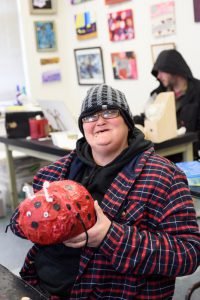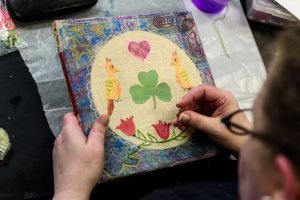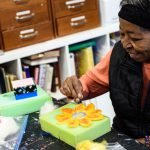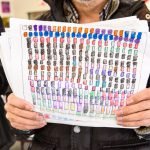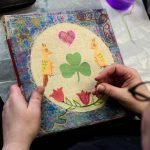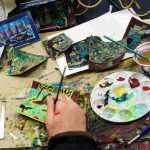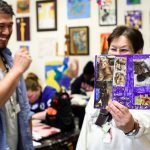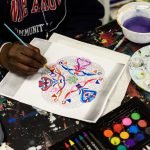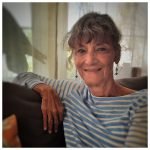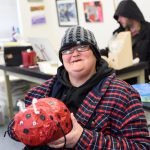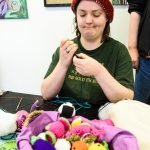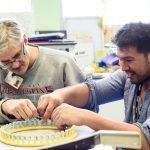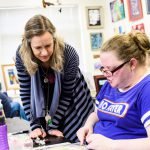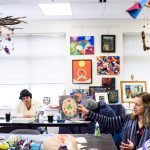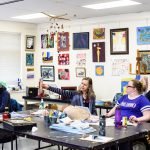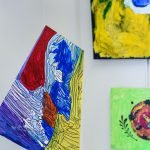+ By Katherine Matuszak + Photos by Alison Harbaugh
This year, more than 42 million—one in four—Americans will experience a mental health disorder regardless of age, race, religion, gender, or economic status. Such a disorder could include depression, anxiety, attention deficit disorder, obsessive-compulsive disorder, bipolar disorder, or schizophrenia, among others. According to the American Psychological Association, only 44 percent of individuals with a mental illness receive the treatment they need. One contributing factor is lack of access to care: either behavioral health facilities do not exist in the area of need, or community facilities cater to individuals who have private insurance or who can afford to pay out of pocket for services.
In 1955, the US government began deinstitutionalizing (releasing) long-stay patients—most with behavioral health disorders—from psychiatric hospitals. By the late 1970s, President Jimmy Carter’s Commission on Mental Health stated that deinstitutionalization had “the objective of maintaining the greatest degree of freedom, self-determination, autonomy, dignity, and integrity of body, mind, and spirit for the individual [with mental illness] while he or she participates in treatment or receives services.” This strategy, however, brought with it a new and serious problem: individuals and their families could not find places to receive proper treatment or services, leading many to forgo treatment.
In 1975, a group of parents in Anne Arundel County who found themselves in this situation with their adult children decided to take action by founding Arundel Lodge. The new nonprofit organization set out to improve the lives of children, adults, and families affected by mental health and substance use disorders.
Guided by the Recovery Model, Arundel Lodge’s philosophy is rooted in treating individuals experiencing behavioral health disorders with respect. The focus is on the needs, strengths, and goals of the community members it serves, assisting them in achieving their endeavors, helping them make decisions about treatment through education and linkages, and facilitating opportunities for social interaction, creative expression, and community involvement.
By 2005, growth in the community’s need prompted an expansion. Turning to architect Catherine Purple Cherry, who specializes in designing spaces for people with special needs, a welcoming, healing space was created. The expansion allowed the Arundel Lodge to add programs, such as the Open Eye Gallery and Studio Art Program.
The Open Eye Gallery and Studio Art Program offers a supportive environment for a community of artists in recovery from mental health and substance use disorders to grow, cope with trauma, and gain confidence through the visual arts. Much of the artwork produced by participants in Arundel Lodge’s art program is for sale. Eighty percent of profits from sales go directly to the artists, many of whom are on medical assistance, and the remaining 20 percent helps replenish art supplies. Most importantly, participants have the opportunity to explore their artistic interests and create expressive works that come from the heart.
Works from the Open Eye Gallery are displayed in shows and exhibitions around the community. This has included a recent Artists Without Limits Over the Rainbow show at the Arundel Center. In April, at 49 West Coffeehouse, Winebar & Galley, the exhibit Transformations displayed 54 works by 11 artists and included paintings, drawings, and mixed media. Asymmetrik, a software development company in Annapolis Junction, is hosting a spring and summer show featuring 35 works by 8 artists.
On Tuesday and Wednesday afternoons, the Open Eye Gallery is open to the community for use as a studio space, with a suggested annual donation of $10, plus $2 per visit. While basic drawing supplies are provided, artists are also invited to bring their own supplies. The Open Eye Gallery and Art Studio Program also seeks volunteers to help with activities such as framing and hanging art, offering support and encouragement to clients, and more.
Today, Arundel Lodge serves over 3,000 community members annually and has been designated as a Center for Excellence in Recovery by the State of Maryland. In 2015, it added two important programs: First Step Recovery Program, to assist community members with substance use disorders, and the Marcus Youth and Family Center, which provides services to youth aged 4 to 17. In 2017, Arundel Lodge added a program to support transition-age youth—ages 16 to 25—in identifying educational and career goals and working to achieve them.
One of Arundel Lodge’s most recent endeavors is creating Military Veterans Support Services (MoVeSS) for veterans and their families. MoVeSS will be the “Call for a Cause” at Arundel Lodge’s 2018 annual fall fundraiser. Its theme is “Night in Havana,” and will include dinner, dancing, entertainment, and auctions. The organization is seeking sponsorship and item donations for the event.
Arundel Lodge seeks to improve the health and happiness of individuals and families through recovery-oriented services, and we are fortunate to have such a resource in our community. █
- Artist Colin Lacey is a frequent visitor to the gallery where he has a table set up containing many pieces and works in progres. Colin works in mainly gauche or pen and ink and sells many of his works through the Open Eye Gallery. Photos by Alison Harbaugh. Sugar Farm Productions
- L-R: Janine Carson, Craig C. Green, & Sheryl Perez socialize and work on their respective art works during a daytime open studio at the Open Eye Gallery. The Open Eye Gallery and art program at Arundel Lodge in Edgewater provides a creative space for adults impacted by mental health and substance use disorders. Many of their works are shown around the area at various galleries and museums and sold to the community to pay the artists and cover supply expenses. Photos by Alison Harbaugh. Sugar Farm Productions
- Rahel Polgreen works on one of many of her felted art pieces. The Open Eye Gallery and art program at Arundel Lodge in Edgewater provides a creative space for adults impacted by mental health and substance use disorders. Many of their works are shown around the area at various galleries and museums and sold to the community to pay the artists and cover supply expenses. Photos by Alison Harbaugh. Sugar Farm Productions
- The Open Eye Gallery and art program at Arundel Lodge in Edgewater provides a creative space for adults impacted by mental health and substance use disorders. Many of their works are shown around the area at various galleries and museums and sold to the community to pay the artists and cover supply expenses. Photos by Alison Harbaugh. Sugar Farm Productions
- Michelle Brookshire works on a mixed media piece.
- Artist Colin Lacey is a frequent visitor to the gallery where he has a table set up containing many pieces and works in progres. Colin works in mainly gauche or pen and ink and sells many of his works through the Open Eye Gallery. Photos by Alison Harbaugh. Sugar Farm Productions
- Marcia takes a tea break with Alan Bradley, author of the Flavia deLuce mystery series, at a talk and booksigning in Douglas, Isle of Man. Photo Courtesy of Marcia Talley
- Marcia and her husband, Barry Talley, at a bonfire on Tahiti Beach, Hope Town, Bahamas. Courtesy of Marcia Talley
- Iolanthe, Barry and Marcia’s sailboat, a Wauquiez Pilot Saloon 41, safely docked in Spanish Cay while checking in with Bahamian Customs. Photo courtesy of Marcia Talley
- Elaine Viets and Marcia Talley, Guest of Honor and Toastmistress, respectively, and the 2017 Malice Domestic Conference in Washington, DC Photo courtesy of Marcia Talley
- Art instructor at Arundel Lodge, Mark Rollamas jokes around with artist Diane Armstrong as she proudly shows off her collage work. The Open Eye Gallery and art program at Arundel Lodge in Edgewater provides a creative space for adults impacted by mental health and substance use disorders. Many of their works are shown around the area at various galleries and museums and sold to the community to pay the artists and cover supply expenses. Photos by Alison Harbaugh. Sugar Farm Productions
- The Open Eye Gallery and art program at Arundel Lodge in Edgewater provides a creative space for adults impacted by mental health and substance use disorders. Many of their works are shown around the area at various galleries and museums and sold to the community to pay the artists and cover supply expenses. Photos by Alison Harbaugh. Sugar Farm Productions
- Hallways and rooms throughout the Arundel Lodge are decorated with artworks by the Open Eye Gallery participants. Large mixed media piece “Night Thoughts” by Christian McCarroll. Photos by Alison Harbaugh. Sugar Farm Productions
- Sculpture by Matt Kelley “Stairway to Heaven”, wood and acrylic. Photos by Alison Harbaugh. Sugar Farm Productions
- Marcia’s cottage, SeaLeggs, in Hope Town, Abaco, Bahamas Photo courtesy of Marcia Talley
- The Open Eye Gallery and art program at Arundel Lodge in Edgewater provides a creative space for adults impacted by mental health and substance use disorders. Many of their works are shown around the area at various galleries and museums and sold to the community to pay the artists and cover supply expenses. Photos by Alison Harbaugh. Sugar Farm Productions
- Author, Marcia Talley Photo Courtesy of Marcia Talley
- Alphonso Lee Williams, Sr. & Lois Agee work on their art pieces during an open studio at the Open Eye Gallery at Arundel Lodge. The Open Eye Gallery and art program at Arundel Lodge in Edgewater provides a creative space for adults impacted by mental health and substance use disorders. Many of their works are shown around the area at various galleries and museums and sold to the community to pay the artists and cover supply expenses. Photos by Alison Harbaugh. Sugar Farm Productions
- cover of latest novel, #16 in the series.
- Wendy Berg proudly shows off her paper mache ladybug.
- Margaret Kay creates crocheted animals and food items that she sells at The Open Eye Gallery and art program at Arundel Lodge in Edgewater. The gallery provides a creative space for adults impacted by mental health and substance use disorders. Many of their works are shown around the area at various galleries and museums and sold to the community to pay the artists and cover supply expenses. Photos by Alison Harbaugh. Sugar Farm Productions
- Art instructor Mark Rollamas assists Joey Turner with his weaving during an open studio at the Open Eye Gallery. The Open Eye Gallery and art program at Arundel Lodge in Edgewater provides a creative space for adults impacted by mental health and substance use disorders. Many of their works are shown around the area at various galleries and museums and sold to the community to pay the artists and cover supply expenses. Photos by Alison Harbaugh. Sugar Farm Productions
- Open Eye Gallery Director, Corinna Woodard chats with Michelle Brookshire about her art piece during an open studio at the Arundel Lodge art space. The Open Eye Gallery and art program at Arundel Lodge in Edgewater provides a creative space for adults impacted by mental health and substance use disorders. Many of their works are shown around the area at various galleries and museums and sold to the community to pay the artists and cover supply expenses. Photos by Alison Harbaugh. Sugar Farm Productions
- Artist Colin Lacey is a frequent visitor to the gallery where he has a table set up containing many pieces and works in progres. Colin works in mainly gauche or pen and ink and sells many of his works through the Open Eye Gallery. Photos by Alison Harbaugh. Sugar Farm Productions
- Artist Colin Lacey is a frequent visitor to the gallery where he has a table set up containing many pieces and works in progres. Colin works in mainly gauche or pen and ink and sells many of his works through the Open Eye Gallery. Photos by Alison Harbaugh. Sugar Farm Productions
- Open Eye Gallery Director, Corinna Woodard chats with Michelle Brookshire about her art piece during an open studio at the Arundel Lodge art space. The Open Eye Gallery and art program at Arundel Lodge in Edgewater provides a creative space for adults impacted by mental health and substance use disorders. Many of their works are shown around the area at various galleries and museums and sold to the community to pay the artists and cover supply expenses. Photos by Alison Harbaugh. Sugar Farm Productions
- Open Eye Gallery Director, Corinna Woodard chats with Michelle Brookshire about her art piece during an open studio at the Arundel Lodge art space. The Open Eye Gallery and art program at Arundel Lodge in Edgewater provides a creative space for adults impacted by mental health and substance use disorders. Many of their works are shown around the area at various galleries and museums and sold to the community to pay the artists and cover supply expenses. Photos by Alison Harbaugh. Sugar Farm Productions
- The Open Eye Gallery and art program at Arundel Lodge in Edgewater provides a creative space for adults impacted by mental health and substance use disorders. Many of their works are shown around the area at various galleries and museums and sold to the community to pay the artists and cover supply expenses. Photos by Alison Harbaugh. Sugar Farm Productions
- Artist Colin Lacey is a frequent visitor to the gallery where he has a table set up containing many pieces and works in progres. Colin works in mainly gauche or pen and ink and sells many of his works through the Open Eye Gallery. Photos by Alison Harbaugh. Sugar Farm Productions


